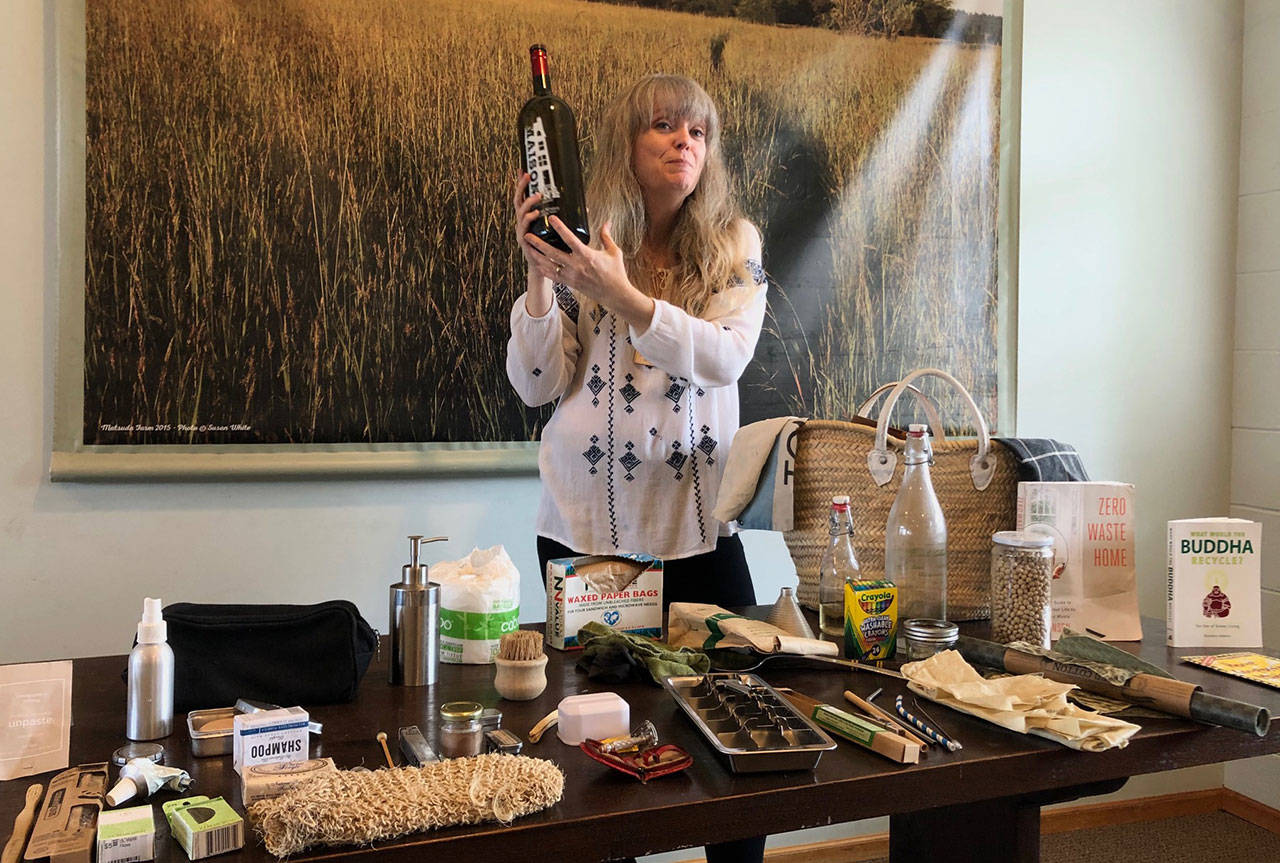With landfills expanding and plastics seemingly swimming in every waterway on earth, there seems to be no way to escape from the increasing streams of waste creating more pollution and harm to the planet.
Or can you?
Siobhan McComb, a mother of two and community educator on the Zero Waste Home, shared tips and tricks with a crowd of over 40 islanders on Saturday, Feb. 29, at the Land Trust Building. The event, sponsored by Windermere island realtors Sarah and Mike Schosboek, was a fundraiser for the Land Trust, raising over $635 for the local stewards of conservation. Sarah Schosboek met McComb when she helped her purchase a home on the island and became interested in sponsoring a talk to help educate other islanders.
“I go from being completely overwhelmed [about the environment] to feeling hopeful that there is action we can take daily,” she said after McComb’s talk.
McComb has been living a Zero Waste lifestyle for over 20 years.
“I read an article on BPA [bisphenol A, a chemical that goes into the making of certain materials and plastics] in the late 80s and that was the beginning of a long road to slowly eliminating plastics out of my life,” McComb told attendees.
Oneglassjar.com, a site created by McComb after friends wanted to know more about her lifestyle, includes tips for a zero-waste kitchen and bathroom — hard to imagine in a world of silicon spatulas, shampoo bottles and plastic-wrapped toilet paper rolls — as well as other spaces of the home.
McComb and her two teenagers produce about a five-gallon bag of garbage every three months, which is not impossible, she said.
McComb suggested a “garbage autopsy,” sorting out all of your waste into piles and breaking it down into “departments,” to help identify where exactly the items that are brought into the home come from. Whether it is the foam tray and plastic wrap on a meat product from the grocery store or a plastic tube of lip gloss, be conscious of the choices you make and think of potential alternatives, she said.
“Is that bag of potato chips worth lasting an eternity?” McComb said about packaging that contains up to seven layers of plastic.
If you cannot live without your chips, try going to Thriftway early when they are first making their fresh potato chips and bring your own natural fiber bags, an alternative to plastic packaging, she said.
Rebecca Drewes, an islander for the last 18 years, attended the talk. Drewes and her husband have been tracking their waste, including recyclables, for a year.
“In the process … that has made us be very aware of the little bits of plastic that are so convenient,” Drewes said. “So I guess for us, we feel that convenience is probably the detriment and probably the god of our society and it is really all about convenience. So we wanted to come here to learn something about alternatives and so this was very eye-opening.”
McComb relies heavily on the bulk section of grocery stores. Bringing her own glass jars with the weight listed on the bottom of each container, she fills up on bulk liquids such as shampoo or honey, and food like nuts, flours, dried fruits and a vast selection of bulk goods. She said sometimes she gets a “funny look” from another shopper with all of her reusable gear and sometimes it’s a curious question that starts a conversation.
She makes her choices carefully and consciously and looks out for “sneaky plastics” — items that may surprise you which contain plastic — some wine bottles without natural corks; silicone in parchment paper; the fleece hoodie that releases micro-fibers every wash cycle. There are things she makes concessions for like wrapped cheese, bread and meats, which are more challenging items to make on her own or buy without packaging (although some grocery stores will wrap meat or cheese in plain butcher paper which cuts down on the foam trays and plastic wraps). McComb does that when she can and doesn’t beat herself up if she can’t.
McComb also said the use of wood or bamboo is a better alternative to plastic because they break down. A further option is using long-lasting materials, such as metal or glass. Soups and frozen fruit can be filled to just under the shoulder of a glass jar to account for expansion, to store in the freezer rather than using plastic bags.
She also touched upon the clothing and textile industry, one of the lesser-known major contributors to pollution.
According to the UN Environmental Programme website, “The fashion industry produces 20% of global wastewater and 10% of global carbon emissions — more than all international flights and maritime shipping.”
Materials like fleece, microfiber, Lycra (think the popularity of yoga pants) when washed, send microplastic particles into waterways and oceans that end up in marine life, McComb explained. She buys things second hand or items that can be repaired and worn again. Using all things to the end of their useful life helps reduce the waste stream, she said. A t-shirt, for example, could be cut up and begin a new life as a cleaning rag.
With over 75 examples of zero waste alternatives on the table, McComb challenged the audience to take just five ideas and start to use them today and shop consciously.
For more information on living a Zero Waste Life, visit oneglassjar.com or ZeroWasteVashon.org. Join McComb on Tuesday, April 18, at the Vashon Library for an additional talk on the Zero Waste Home.


